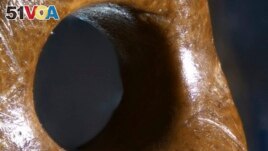New research suggests humans lived in South America at the same time as giant sloths, big animals that disappeared thousands of years ago. The findings support evidence that people arrived in the Americas thousands of years earlier than once thought.
Scientists looked at small pendants made of bony material from the sloths. The pendants have round holes in them and look polished. The team of researchers said the pendants show signs that humans made them.
The scientists published their findings in Proceedings of the Royal Society B. They reported that the material in which the pendants were found dates from 25,000 to 27,000 years ago.

This image provided by researchers shows a closeup of an artifact, presumed to be a pendant, made of bony material from a giant sloth discovered at a rock shelter in Brazil, recovered from archaeological layers dated to 25,000 to 27,000 years ago.(Thais Rabito Pansani via AP)
"We now have good evidence — together with other sites from South and North America — that we have to rethink our ideas about the migration of humans to the Americas," said Mirian Pacheco. She is a co-writer of the study and an archaeologist at the Federal University of Sao Carlos in Brazil.
Some earlier theories had suggested the first people arrived in the Americas around 15,000 years ago.
The pendants were found 30 years ago in the Santa Elina rock shelter in central Brazil. The new study is the first to carefully study them. The scientists ruled out the possibility that humans had found and made them thousands of years after the animals died. Instead, they say the pendants were made within days or a few years after the animal died.
"We think they were personal objects, possibly for personal adornment," said Thais Rabito Pansani, a co-writer and paleontologist at the Federal University of Sao Carlos in Brazil.
Once among the largest animals in South America, giant ground sloths were three to four meters long and usually walked on all four legs. They weighed more than 450 kilograms.
Other evidence from Mexico suggests humans may have been present in the Americas around 26,000 years ago. Discoveries from Uruguay suggest humans were living there 30,000 years ago.
The evidence from more than one place means scientists have begun to rethink their ideas about human migration. This includes the idea that the first people in the Americas came over what is known as the Bering Land Bridge around 15,000 years ago.
Briana Pobiner is another co-writer of the study. She is a paleoanthropologist at the Smithsonian Institution's National Museum of Natural History in Washington.
While some early populations may have died out in the Americas, "it's very likely that multiple waves of people came to [the] Americas," she said.
I'm Andrew Smith.
Christina Larson reported this story for the Associated Press. Andrew Smith adapted it for VOA Learning English.
_______________________________________________________________________
Words in This Story
pendant –n. an object worn around the neck meant to be attractive; a piece of jewelry
polished –adj. a surface that is rubbed or treated in a way that makes it shiny and smooth
adornment –n. something that is worn to improve a person's appearance
paleoanthropologist –n. a person who studies prehistoric people
rule out –v. (phrasal) to remove from consideration
